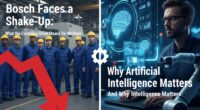Communication first, knowledge work next (with data you can use)
By Thorsten Meyer AI
TL;DR
New, usage‑grounded evidence from 200,000 Bing Copilot conversations shows that today’s AI is most applicable to communication‑heavy and knowledge‑work activities. Figure 5 highlights the top work activities (IWAs)—chiefly delivering information to people—that flow into occupations like Sales Representatives, Customer Service Representatives, Concierges, Broadcast Announcers, and Passenger Attendants. Aggregated to broad SOC job families (Table 5 below), Sales; Computer & Mathematical; and Office & Administrative Support have the highest AI applicability scores, with Healthcare Support and physically intensive or machinery‑based jobs at the bottom. arXiv+1
What Figure 5 Shows: AI thrives where the job is “information in → information out”
Figure 5 connects the work activities people actually do with AI to the occupations they support. The left side lists the most influential IWAs (Intermediate Work Activities, from O*NET); the right shows the 25 occupations with the highest AI applicability scores, sized by employment and sorted by score. The punchline: AI’s comparative advantage today is communicating information. arXiv
Top communication‑centric IWAs (the biggest contributors):
- Provide information to customers
- Respond to customer inquiries
- Provide general assistance to others
- Provide information to the public
- Promote products, services, or programs
- Explain technical details of products
- Present research or technical information
- Prepare informational materials
- Maintain knowledge in area of expertise
- Gather information from various sources
- Edit written materials or documents
- Write artistic or commercial material
- Interpret language/cultural information
- Program computer systems or equipment
- Compile records or documentation
- Evaluate data quality or accuracy
- Develop news, entertainment, or art
- Research information or social issues
- Examine materials for accuracy
(Figure labels shortened for space in the paper.) arXiv
Who benefits most from those IWAs?
The 25 occupations with the highest AI applicability scores include (employment in parentheses): Sales Representatives (1.1 M), Customer Service Representatives (2.9 M), Hosts & Hostesses (430 K), Interpreters & Translators (52 K), Broadcast Announcers & DJs (25 K), Concierges (41 K), Ticket Agents & Travel Clerks (120 K), Telemarketers (82 K), Product Promoters (51 K), Advertising Sales Agents (110 K), PR Specialists (280 K), Business Teachers, Postsecondary (83 K), Editors (96 K), Technical Writers (48 K), Writers & Authors (49 K), Proofreaders & Copy Markers (5.5 K), Reporters & Journalists (45 K), Political Scientists (5.6 K), Historians (3 K), Mathematicians (≈2.2 K), Brokerage Clerks (48 K), Telephone Operators (4.6 K), CNC Tool Programmers (28 K), Passenger Attendants (20 K), and Farm & Home Management Educators (8.1 K). The common thread: delivering, shaping, and explaining information. arXiv
Knowledge‑work IWAs also score high
Beyond customer‑facing comms, the study finds strong signals for knowledge work IWAs—Edit written materials, Maintain knowledge, Write artistic/commercial materials, Interpret language/cultural information, and Program computers—flowing into Technical Writers, Editors, Brokerage Clerks, Political Scientists, Mathematicians, Writers, PR Specialists, Interpreters/Translators, and CNC Tool Programmers. In short, where the core work product is text, language, code, or structured analysis, AI already performs usefully. arXiv
The broad picture by job family (SOC major groups)
To see where this adds up at scale, the authors aggregate occupations into 22 SOC major groups and compute a composite AI applicability score (which blends coverage of a group’s activities in real AI use, completion rates, and scope of AI’s impact). The top families are where communication or symbol manipulation (writing, analysis, code) dominate day‑to‑day work; the bottom are physically embodied or equipment‑oriented roles where AI helps around the edges but not at the core. arXiv
SOC Major Groups — Sorted by AI Applicability Score (from the paper’s Table 5)
Metrics are the mean of user‑goal and AI‑action evaluations. “Score” combines coverage, completion, and scope. arXiv
| Major Group | Coverage | Completion | Scope | Score | Employment |
|---|---|---|---|---|---|
| Sales and Related | 0.56 | 0.89 | 0.51 | 0.32 | 13,266,370 |
| Computer and Mathematical | 0.64 | 0.86 | 0.48 | 0.30 | 5,177,390 |
| Office and Administrative Support | 0.56 | 0.89 | 0.49 | 0.29 | 18,163,760 |
| Community and Social Service | 0.51 | 0.88 | 0.44 | 0.25 | 2,216,930 |
| Arts, Design, Entertainment, Sports, Media | 0.59 | 0.80 | 0.49 | 0.25 | 2,039,830 |
| Business and Financial Operations | 0.49 | 0.89 | 0.47 | 0.24 | 10,087,850 |
| Educational Instruction and Library | 0.46 | 0.89 | 0.46 | 0.23 | 8,328,920 |
| Architecture and Engineering | 0.49 | 0.84 | 0.46 | 0.22 | 2,523,090 |
| Personal Care and Service | 0.39 | 0.90 | 0.45 | 0.20 | 2,959,620 |
| Life, Physical, and Social Science | 0.39 | 0.88 | 0.46 | 0.20 | 1,381,930 |
| Food Preparation and Serving Related | 0.32 | 0.91 | 0.43 | 0.18 | 13,142,870 |
| Management | 0.27 | 0.90 | 0.45 | 0.14 | 10,445,050 |
| Protective Service | 0.33 | 0.84 | 0.40 | 0.14 | 3,484,710 |
| Legal | 0.33 | 0.89 | 0.42 | 0.13 | 1,196,870 |
| Healthcare Practitioners and Technical | 0.25 | 0.91 | 0.39 | 0.12 | 9,251,930 |
| Installation, Maintenance, and Repair | 0.22 | 0.92 | 0.41 | 0.11 | 5,979,150 |
| Production | 0.23 | 0.91 | 0.41 | 0.11 | 8,419,460 |
| Transportation and Material Moving | 0.21 | 0.92 | 0.38 | 0.11 | 13,664,940 |
| Building, Grounds Cleaning, Maintenance | 0.15 | 0.94 | 0.38 | 0.08 | 4,403,350 |
| Construction and Extraction | 0.16 | 0.92 | 0.40 | 0.08 | 6,188,720 |
| Farming, Fishing, and Forestry | 0.11 | 0.92 | 0.39 | 0.06 | 422,740 |
| Healthcare Support | 0.13 | 0.90 | 0.38 | 0.05 | 7,063,540 |
Interpretation: High‑scoring groups (e.g., Sales; Computer & Mathematical; Office/Admin) are either customer‑communication or symbol‑manipulation domains. Lower‑scoring groups skew toward physical labor or machinery operation; AI still completes tasks it touches (note consistently high completion), but the coverage of core activities is smaller and scope per activity is narrower. arXiv
Assistance vs. performance: why this distinction matters
The paper distinguishes between user goals (what the person is trying to achieve) and AI actions (what the system actually does). This cleanly separates assistance from performance:
- High assistance, low performance: Occupations with physical components (e.g., cooking, working with animals) often show evidence that AI can guide or coach but not do the embodied task—think Cooks or Animal Breeders. arXiv
- High performance, lower assistance: Occupations centered on teaching, training, managing, communicating (e.g., Training & Development Managers, Coaches & Scouts, HR Specialists) show AI carrying more of the activity itself (drafting materials, structuring guidance, providing information), rather than just advising a user who then executes. arXiv
Understanding this split helps leaders design workflow handoffs: where AI can perform (e.g., drafting, summarizing, coding), automate it; where AI primarily assists, keep humans in the loop for the decisive or physical step.
A note on the SOC minor‑group view
Dropping one level down (Table A2 in the paper), the highest‑scoring minor groups are Media & Communication, Mathematical Science, Sales Representatives of Services, Communications Equipment Operators, and Information & Record Clerks—again, where the unit of work is message handling, meaning‑making, and structured information. arXiv
What to do with this (practical playbook)
For revenue & service teams (Sales, Support, Community/Social Service):
- Use AI to triage inbound inquiries, draft outbound responses, standardize FAQs/knowledge bases, and coach reps. Expect strong completion on these IWAs and wide coverage across your workflows. arXiv
For knowledge‑work orgs (Product, Research, Policy, Comms, Engineering):
- Scale AI for drafting, editing, summarizing, translation, code generation, data/document hygiene. These IWAs already score high on applicability and completion. arXiv
For physically anchored operations (Healthcare support, Construction, Production, Transport):
- Focus AI on the surrounding information work: planning, checklists, training briefs, troubleshooting, documentation, and shift handoffs. Gains come from high completion on narrower coverage tasks that wrap the physical core. arXiv
Method at a glance (why these numbers are credible)
- Data: ~200,000 anonymized U.S. Copilot conversations from Jan–Sep 2024. arXiv
- Task lens: Conversations mapped to O*NET Intermediate Work Activities (IWAs) for both user goals and AI actions. arXiv
- Success & scope: A lightweight LLM judges task completion; scope measures how much of an activity the AI covered in the exchange. arXiv
- Applicability score: Blends coverage (non‑trivial usage of an occupation’s IWAs; threshold 0.05%), completion, and scope, weighted by O*NET activity relevance within each occupation. arXiv
- Aggregation: Occupation‑level results rolled up to SOC major groups (Table 5). arXiv
Source
K. Tomlinson, S. Jaffe, W. Wang, S. Counts, S. Suri (2025). “Working with AI: Measuring the Occupational Implications of Generative AI.” arXiv:2507.07935. (See Figure 5 and Table 5 for the data summarized here.) arXiv+1









